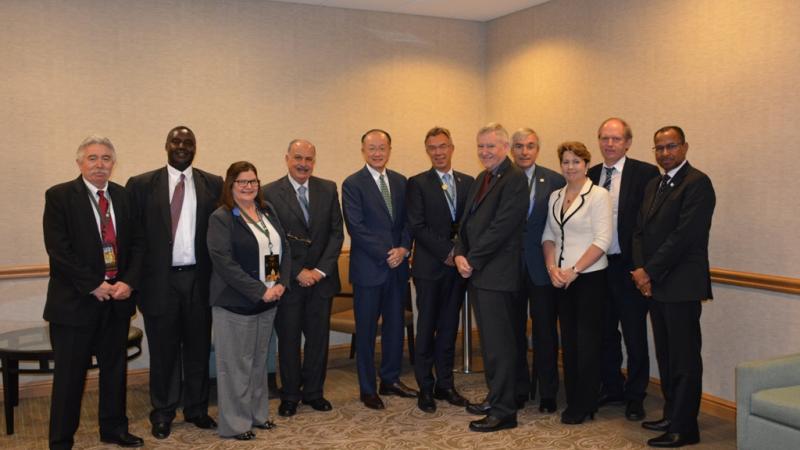CGIAR Center Directors meet President of the World Bank to discuss global impacts of agricultural research and solutions.
Published Date
October 18, 2016

CGIAR Director Generals with the President of the World Bank, Dr. Jim Yong Kim (center)
A CGIAR delegation, comprising the Directors General and senior management of CIAT, CIMMYT, CIP, ICARDA, ILRI and ICRISAT met Dr. Jim Yong Kim, World Bank President at the World Food Prize symposium in October, to review the potential returns on investment from World Bank’s continued partnership with CGIAR. With decades of support to agricultural research for development, there are now a suite of technologies available with CGIAR, ready for scaling out and unleashing their potential in improving the lives and well-being of millions of poor, along with environmental benefits – a win-win for several of the UN’s Sustainable Development Goals.
ICARDA’s briefing to Dr. Kim focused on the benefits that agricultural research and solutions can offer to dryland regions. These countries, home to 2.5 billion people, cover 40% of the earth’s surface and include areas that are the hardest hit by climate change.
Dr. Kim expressed concern about the stunting and malnutrition of children that’s a major challenge for development community. He also drew attention to the influx of refugees from Syria, other Middle Eastern and African countries, to Europe.
ICARDA’s former Director General, Dr. Mahmoud Solh (2006-2016), presented ICARDA’s achievements and the value that investments in agriculture and the resulting technologies can bring to dryland rural communities. The underlying cause of today’s migration situation lie in food insecurity, poverty and unemployment, he said. Dr. Solh stressed on the importance of drylands research in reversing this situation. “Agricultural innovation and technologies, practices and policy options developed and tested by ICARDA with drylands partner countries have demonstrated improved agricultural performance, and brought more income and better nutrition to the people,” stated Dr. Solh.
Many technologies are validated for benefits and ready for scaling out. These include raised-bed planting that uses 25% less water and increases wheat yields by 20% on average; introduction of food legumes into cereal cropping systems – for more nutritive diets and extra income for rural communities; and the wealth of drylands plant genetic resources freely available to countries worldwide for breeding heat and drought-resistant crops that are higher yielding.
“Today’s challenge is to bring these innovations to scale across all drylands countries in agricultural value chains. The results will be reduced problems of malnutrition, higher crop yields – up to 200% in some cases – and new income and employment opportunities,” commented Dr. Solh.
Dr. Solh explained how applying these innovations to improve livelihoods and food production systems will foster well-being, contentment and stability. A food secure region that provides stable food supply for the people of the world’s most marginalized environments will, over the long term, have a stabilizing effect on the politics and society.
Sharing ICARDA’s experiences, he added, “It is entirely possible to double yields per hectare – of wheat, lentil, grass pea, chickpea and other crops – by combining improved crop varieties with innovative practices and technologies. These achievements have been validated and field-tested in dozens of large-scale field trials over the past decade. By investing more in agriculture innovation and research we will bring these approaches to scale, and will improve the lives of millions across all drylands countries.”
